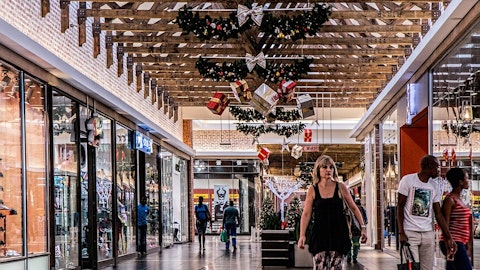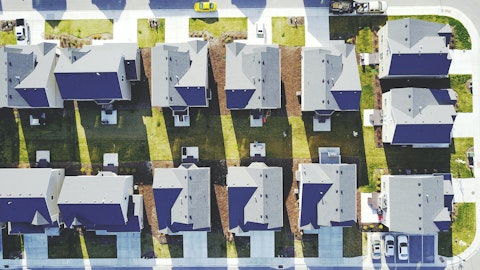Dave Jamieson: Yes, appreciate the question. I think it sort of dovetails part of what Conor mentioned about the supply demand and the demand factors that are very much in our favor right now with no new development supply. It’s really the existing inventory. And so, similar message to what we’ve communicated previously is a lot of these retailers are looking for opportunities to grow their store count. They have to hit their growth projections over the next several years and so they’ve always seen the Bed Bath inventory as one of those clear opportunities. So in terms of the commitment they’ve made, you have multiple players at the table looking for a similar space that actually helps you push rent northward, which helps drive the spread.
When you look at the cost side, the costs have been pretty much in line. All of these have been single tenant backfills, so we aren’t splitting boxes yet. When you look at the balance of the 12, we still have a handful of those that are going to be occupied most likely by single tenant users. There may be a couple in there that we anticipate splitting, but that was to be expected from the very beginning and we still see very healthy spread margins as well for those remaining boxes. So again, all looks fairly comparable right now.
Operator: The next question comes from Samir Khanal with Evercore ISI. Please go ahead.
Samir Khanal: Yes. Hi, good morning. Maybe a follow-up to the Bed Bath sort of comment earlier. I guess how much — how should we think about the downtime with those boxes? I mean, I’m trying to figure out, you know, the downtime and how long it’ll take to get kind of the rent back online with new tenants as we think about growth for next year, you know. So, you know, on the one side you have the headwinds from higher interest rates, net interest expense, but on the other side I’m just trying to understand how much of a sort of a pick-up from rents you’ll get sort of as a tailwind for next year? Thanks.
Dave Jamieson: Yes, sure, absolutely. So we have 14 boxes that were executed three of which were assigned those 14 boxes are accounted for currently in our snow pipeline, which you spend a 320 basis points, $52 million in total. For some perspective on timing, we do actually have our first two Bed Bath boxes that were backfilled starting to flow this quarter, and so that was under a 12-month window. Obviously, timing will vary box-to-box on what needs to be done. The balance of that is baked into our snow pipeline, of which we anticipate seeing about 50% to 60% of that flow through the course of 2024.
Conor Flynn: The nice part, too, about the releasing of the Bed Bath boxes is, again, there have been individual tenants taking the whole boxes, which usually compresses the buildout time and the rent commencement date. So that’s what we’re already starting to see some flow this year.
Operator: The next question comes from Dori Kesten with Wells Fargo. Please go ahead.
Dori Kesten: Thanks. Good morning. With respect to your push for higher annual escalators, are you finding there’s any incremental pushback or would you expect to be able to continue to push upward to the near-term?
Glenn Cohen: Yes it’s market driven obviously you know we’d say the Sun Belt markets have been you know areas of opportunity where we can push further north on the increases, but it’s really a case-by-case conversation with all the retailers. Obviously, everything’s in negotiation, so there’s a lot of discussion on the table, but we felt we have been confident in our abilities to push it northward, and right now it seems to be holding pretty well. With the small shop occupancy at 91.1, obviously matching our all-time high, again, that supply-demand balance is still working very much in our favor.
Dori Kesten: Okay, thanks.
Operator: The next question comes from Connor Mitchell with Piper Sandler. Please go ahead.
Connor Mitchell: Hey, good morning. Thanks for taking my question. So, sticking with the lack of supply and strong tenant demand, I guess thinking about how you guys are having conversations and discussions with your acre tenants. So, traditionally, the acre tenants are able to drive leasing terms on deals. But now that the availability is dwindling. How is Kimco able to regain leverage in those discussions and maybe curtail some tenant-friendly terms?
Conor Flynn: Sure. Yes, I mean, outside of the economics, you’re looking at, you know, co-tenancy provisions, exclusive provisions, all of which you can start to rebalance, loosen up, create more flexibility for us. Obviously, repositioning and redeveloping our centers has been a core principle of ours, so having that flexibility to do so. I also think we continue to grow into a data-driven market where you have a better sense of the impacts and you see tendencies or understandings change. Former principles about the impact of fitness long ago was sort of dispelled by the reality that people go to the gym, and then they actually go and shop elsewhere afterwards. And so retailers have come to appreciate that. So I think today, more than ever, it’s very much a partnership, looking to build the best community for the shopper and the customer. And our retailer partnerships are very, very strong. And they’re willing to explore new opportunities that work for both sides.
Glenn Cohen: The only thing I would add is I think you’re seeing retailers become more flexible with store footprint, which again opens up a lot more opportunities. The days of sort of having their prototype and that’s it, it seemed to be in the past. And so that may not be a lease term specific item, but it is an optionality that creates more demand for spaces that might be more tweener sized. And that’s what you’re seeing with some of the Bed Bath opportunities.
Operator: The next question comes from Floris van Dijkum with Compass Point. Please go ahead.
Floris van Dijkum: Thanks, good morning guys. Thanks for taking my question. You know, I’m a little bit surprised that you know in some ways on the reaction from the market on your increasing scale at a time when the fundamentals of the shopping center industry are probably the best we’ve ever seen. But maybe if you could put into context some of the — your historical occupancy and leverage ratios. And in particular maybe highlight also maybe if you can talk about what your shop occupancy is at record levels already, but are there big regional differences and how much more can you push that? Maybe comparing, for example, your New York or Long Island shop occupancy versus your national, obviously there are market differences here, but highlight to the market a little bit on what the upside potential, additional upside potential is here in terms of occupancy.
And also, obviously, as that snow pipeline comes online, what that would do to your already, I believe, record low leverage ratios?
Conor Flynn: Sure. Happy to start, Floris, and we can pass the mic around, but you’re spot-on. We’re obviously encouraged by the supply and demand dynamic that we’re experiencing in our portfolio. We’re using a lot of data analytics to understand that there’s virtually no new supply on the horizon and that we feel like our portfolio is well positioned for growth as the signed, but not open pipeline continues to build, as you saw expand further this quarter, which indicates future NOI growth. And we’re trying to maintain a portfolio and strategy that allows us to grow regardless of the environment that we’re facing. And so keeping leverage levels at all-time lows for us is important. You saw us be proactive and really sort of push out any near-term maturities with our recent bond offering.
We continue to think that the small shop occupancy is going to be a bright spot for us as we’ve just reached all-time highs and we’re continuing to think there’s more to push there. The demand drivers are multiple, and they’re more, as I mentioned earlier, there’s traditional and there’s non-traditional. And you continue to see the use cases for shopping centers evolve, because it’s all about value and convenience. And almost everything you can think of benefits from value and convenience. And so that’s why the shopping center continues to evolve to be, I think, the place of choice for whether it’s a service use, whether it’s a medical use, whether it’s a pure retail use, you name it, it continues to evolve as the spot where people want to start businesses.



